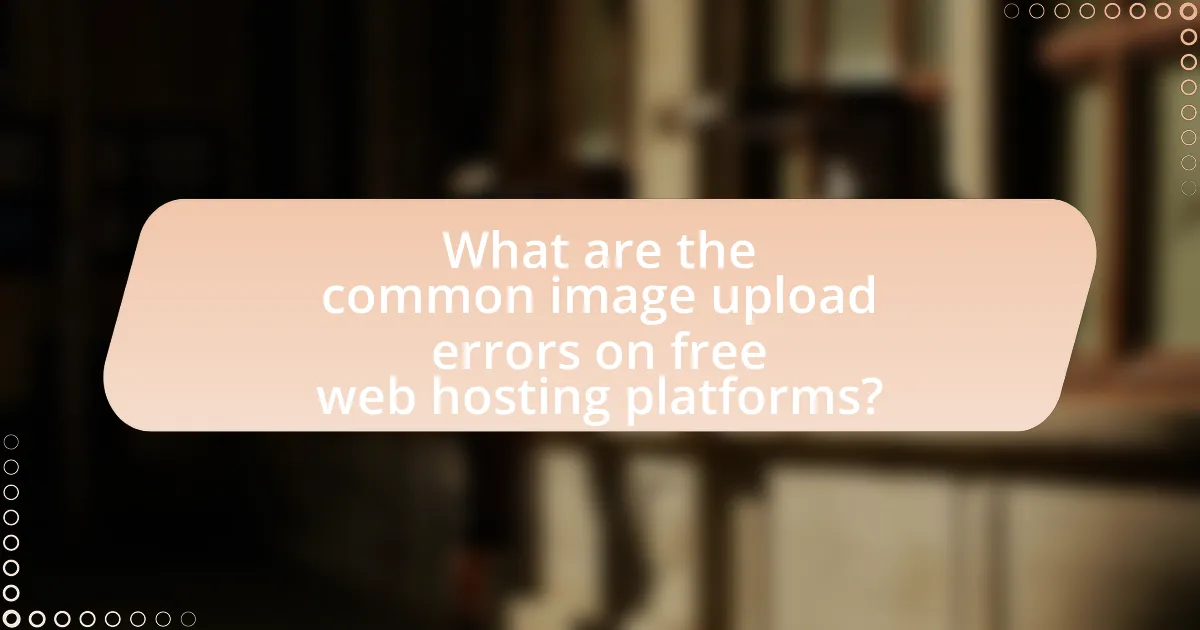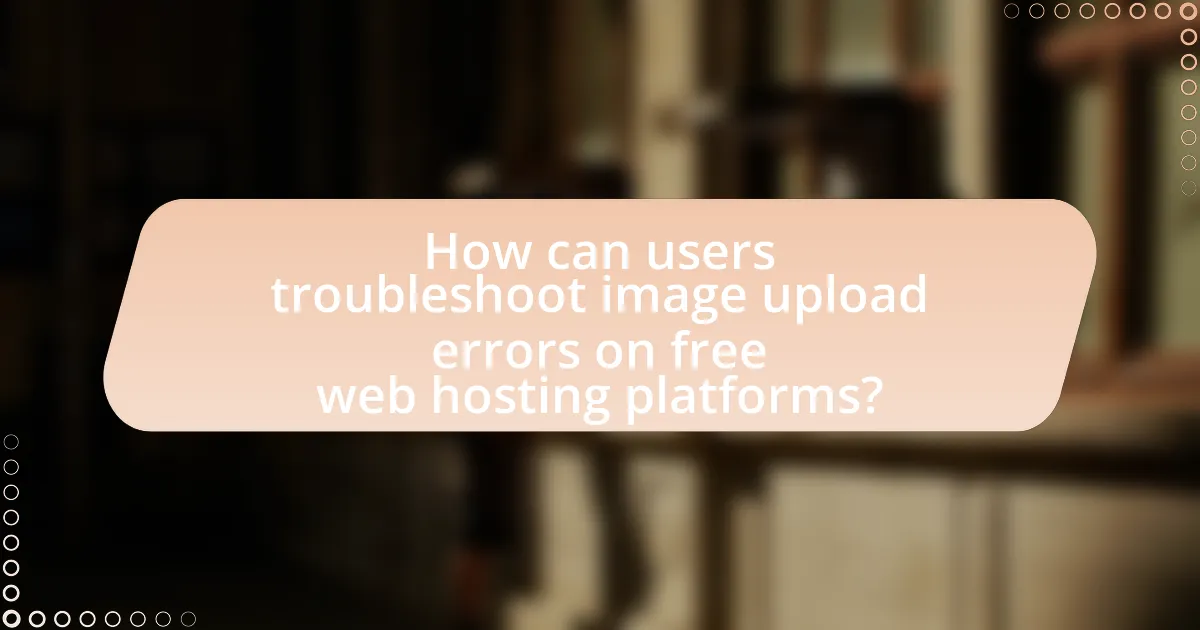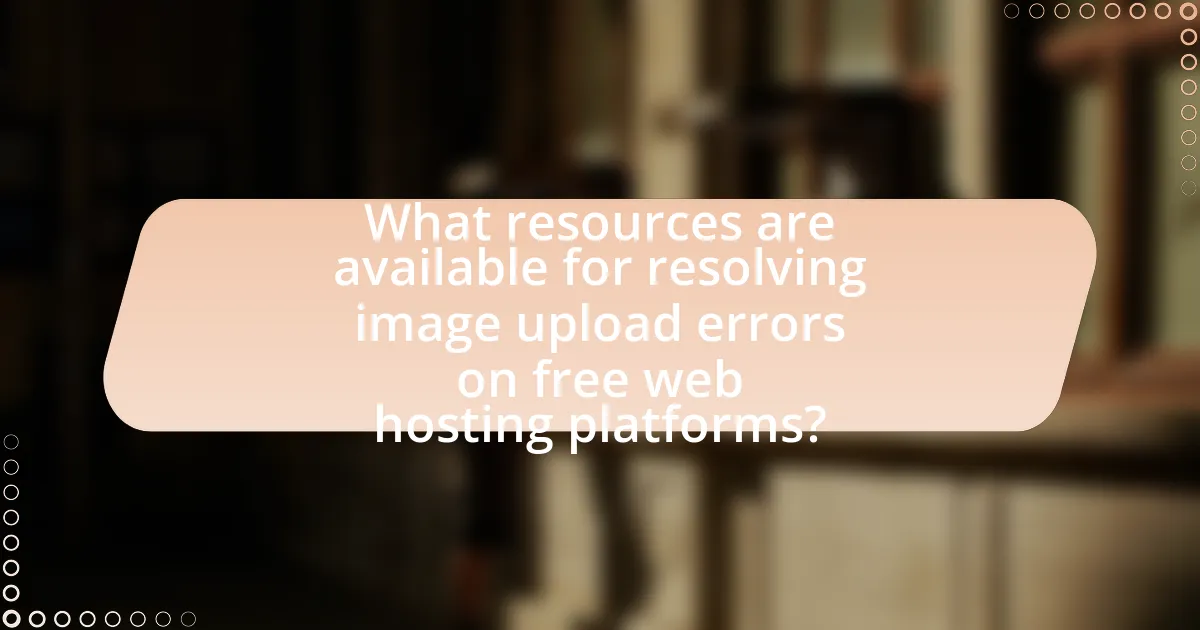The article focuses on resolving image upload errors encountered on free web hosting platforms. It identifies common issues such as file size limitations, unsupported file formats, and permission settings that can hinder successful uploads. Key strategies for troubleshooting these errors include optimizing image sizes, ensuring compatibility with accepted formats, and adjusting permission settings. Additionally, the article provides resources and tools for users to effectively diagnose and resolve upload issues, enhancing their experience on free hosting services.

What are the common image upload errors on free web hosting platforms?
Common image upload errors on free web hosting platforms include file size limitations, unsupported file formats, and server timeout issues. File size limitations often restrict images to a maximum size, typically around 2MB, which can prevent larger images from being uploaded. Unsupported file formats, such as certain RAW or TIFF files, may lead to errors if the platform only accepts JPEG or PNG formats. Server timeout issues can occur due to slow internet connections or server overload, resulting in failed uploads. These errors are frequently encountered by users on free hosting services due to their inherent restrictions and resource limitations.
How do file size limitations affect image uploads?
File size limitations directly restrict the maximum size of images that can be uploaded to a platform. When an image exceeds the specified limit, the upload process fails, resulting in an error message for the user. For instance, many free web hosting platforms impose a limit of 2MB per file, which can hinder users from uploading high-resolution images or multiple files at once. This limitation can lead to frustration and may require users to compress images or reduce their quality, impacting the overall visual presentation of their content.
What are the typical file size limits imposed by free hosting services?
Typical file size limits imposed by free hosting services range from 2 MB to 10 MB per file. Many free hosting providers, such as WordPress.com and Wix, enforce these limits to manage server resources and ensure fair usage among users. For instance, WordPress.com has a 3 MB limit for image uploads, while Wix allows up to 10 MB per file. These restrictions can lead to image upload errors if users attempt to upload files exceeding the specified limits.
How can users optimize images to meet these limits?
Users can optimize images to meet upload limits by reducing their file size and dimensions. This can be achieved through various methods such as using image compression tools like TinyPNG or JPEGmini, which decrease file size without significantly affecting quality. Additionally, converting images to more efficient formats like WebP can further reduce file size. Resizing images to the maximum dimensions allowed by the hosting platform also helps in meeting the limits. According to a study by Google, using optimized images can improve loading times by up to 80%, demonstrating the effectiveness of these optimization techniques.
What role do file format restrictions play in image upload errors?
File format restrictions significantly contribute to image upload errors by limiting the types of files that can be successfully uploaded to a platform. When a user attempts to upload an image in an unsupported format, such as TIFF or BMP, the system generates an error message, preventing the upload from completing. This is because many web hosting platforms only accept common formats like JPEG, PNG, or GIF due to compatibility and performance considerations. For instance, a study by W3Techs indicates that over 90% of websites utilize JPEG and PNG formats, highlighting their prevalence and acceptance in web environments. Thus, understanding and adhering to file format restrictions is crucial for users to avoid upload errors and ensure successful image integration on free web hosting platforms.
Which file formats are commonly accepted by free web hosting platforms?
Free web hosting platforms commonly accept file formats such as HTML, CSS, JavaScript, JPEG, PNG, GIF, and PDF. These formats are widely supported due to their compatibility with web standards and ease of use for website development and content display. For instance, HTML and CSS are essential for structuring and styling web pages, while image formats like JPEG and PNG are preferred for visual content due to their balance of quality and file size. Additionally, PDF is often accepted for document sharing, making it versatile for various types of content.
How can users convert images to compatible formats?
Users can convert images to compatible formats by utilizing image conversion software or online tools. These tools allow users to upload their images and select the desired output format, such as JPEG, PNG, or GIF. Many of these services support batch processing, enabling users to convert multiple images simultaneously, which is particularly useful for resolving upload errors on free web hosting platforms that may have specific format requirements. For instance, online converters like Zamzar or CloudConvert provide straightforward interfaces for format conversion, ensuring that images meet the necessary specifications for successful uploads.
Why do permission settings lead to upload failures?
Permission settings lead to upload failures because they control access rights for files and directories on a server. When these settings are incorrectly configured, they can prevent users from writing or modifying files, resulting in failed upload attempts. For instance, if a directory’s permissions are set to read-only, the server will deny any upload requests, leading to errors. This is particularly common on free web hosting platforms, where default permission settings may not allow sufficient access for file uploads.
What are the common permission settings that affect uploads?
Common permission settings that affect uploads include file permissions, directory permissions, and user roles. File permissions determine who can read, write, or execute files, typically set using numeric values like 644 for files and 755 for directories. Directory permissions must allow write access for the user or group responsible for uploads; otherwise, the upload process will fail. User roles, such as administrator or contributor, also dictate the ability to upload files, with administrators generally having full access while contributors may have restricted permissions. These settings are crucial for ensuring that the web server can handle file uploads correctly, as improper configurations can lead to upload errors.
How can users adjust permissions to resolve upload issues?
Users can adjust permissions by modifying the file and folder settings in their web hosting control panel. Specifically, they should ensure that the permissions for the upload directory are set to 755 or 775, allowing the web server to write files. This adjustment is crucial because incorrect permissions can prevent the server from accessing or writing to the directory, leading to upload failures. For instance, many web hosting platforms default to more restrictive permissions, which can block uploads. By setting the correct permissions, users can effectively resolve these upload issues.

How can users troubleshoot image upload errors on free web hosting platforms?
Users can troubleshoot image upload errors on free web hosting platforms by checking file size limits, ensuring correct file formats, and verifying internet connectivity. Many free hosting services impose restrictions on file sizes, typically around 2MB, which can lead to upload failures if exceeded. Additionally, users should confirm that their images are in supported formats such as JPEG, PNG, or GIF, as unsupported formats will not upload successfully. Lastly, a stable internet connection is crucial; intermittent connectivity can interrupt the upload process, resulting in errors.
What steps should be taken to identify the cause of upload errors?
To identify the cause of upload errors, first check the file size and format to ensure they meet the hosting platform’s requirements. Many free web hosting platforms impose limits on file sizes and specific formats, which can lead to errors if exceeded. Next, examine the internet connection for stability, as interruptions can cause uploads to fail. Additionally, review any error messages provided by the platform, as they often contain clues about the issue. Finally, test the upload process with different files to determine if the problem is file-specific or a broader issue with the hosting service.
How can users check error messages for clues?
Users can check error messages for clues by carefully reading the text displayed in the error notification. Error messages often contain specific codes or descriptions that indicate the nature of the problem, such as file size limits, unsupported formats, or permission issues. For instance, a message stating “File size exceeds limit” directly points to the need to reduce the image size before attempting to upload again. Analyzing these messages helps users identify and resolve issues effectively, as they provide actionable insights into what adjustments are necessary for successful uploads.
What tools can assist in diagnosing upload issues?
Tools that can assist in diagnosing upload issues include network monitoring software, file transfer protocol (FTP) clients, and web debugging tools. Network monitoring software, such as Wireshark, allows users to analyze network traffic and identify potential bottlenecks or interruptions during the upload process. FTP clients, like FileZilla, provide detailed logs that can help pinpoint errors related to file permissions or connection issues. Web debugging tools, such as Chrome DevTools, enable users to inspect network requests and responses, revealing any errors that occur during the upload process. These tools collectively enhance the ability to diagnose and resolve upload issues effectively.
What are the best practices for successful image uploads?
The best practices for successful image uploads include optimizing image size, using appropriate file formats, and ensuring a stable internet connection. Optimizing image size reduces loading times and prevents upload failures; for instance, images should ideally be under 1MB for faster processing. Using appropriate file formats, such as JPEG for photographs and PNG for graphics with transparency, ensures compatibility with most platforms. Additionally, a stable internet connection minimizes the risk of interruptions during the upload process, which can lead to errors. Following these practices enhances the likelihood of successful image uploads on free web hosting platforms.
How can users prepare images before uploading?
Users can prepare images before uploading by ensuring they meet the required specifications such as file format, size, and resolution. For instance, common formats like JPEG, PNG, or GIF are typically accepted, while file sizes should generally be under 2MB to avoid upload errors. Additionally, images should have a resolution of 72 DPI for web use, which balances quality and loading speed. Following these guidelines minimizes the risk of encountering upload errors on free web hosting platforms, as many impose strict limits on file types and sizes.
What settings should be verified before attempting an upload?
Before attempting an upload, users should verify the file size limit, file type restrictions, and available storage space on the hosting platform. These settings are crucial because exceeding the file size limit can result in upload failures, while unsupported file types will not be accepted by the server. Additionally, insufficient storage space can prevent any new uploads from being completed. For instance, many free web hosting platforms impose a maximum file size of 2MB and only allow specific formats like JPEG or PNG, which users must check prior to uploading.

What resources are available for resolving image upload errors on free web hosting platforms?
Resources available for resolving image upload errors on free web hosting platforms include community forums, official documentation, and troubleshooting guides. Community forums, such as those on Reddit or specific hosting provider websites, allow users to share experiences and solutions. Official documentation from hosting providers often contains specific guidelines on file size limits, supported formats, and common error messages. Troubleshooting guides, available on tech blogs and support websites, provide step-by-step instructions for diagnosing and fixing upload issues. These resources collectively help users identify and resolve image upload errors effectively.
Where can users find support for troubleshooting upload issues?
Users can find support for troubleshooting upload issues on the help or support section of their specific free web hosting platform. Most platforms provide detailed FAQs, user forums, and direct customer support options to assist users in resolving upload errors. For example, platforms like WordPress.com and Wix offer dedicated support articles and community forums where users can seek advice and solutions tailored to their specific upload problems.
What online forums or communities are helpful for users facing these problems?
Online forums and communities that are helpful for users facing image upload errors on free web hosting platforms include Stack Overflow, Reddit’s r/webdev, and the Web Hosting Talk forum. Stack Overflow provides a vast repository of questions and answers related to web development issues, including image upload problems, where users can seek specific technical advice. Reddit’s r/webdev offers a community of web developers who share experiences and solutions regarding various web hosting challenges, including image uploads. Web Hosting Talk is a dedicated forum for discussions about web hosting services, where users can find threads specifically addressing image upload errors and share their solutions. These platforms collectively offer a wealth of knowledge and peer support for resolving such issues.
How can users access customer support from hosting providers?
Users can access customer support from hosting providers through multiple channels, including live chat, email, and phone support. Many hosting providers offer 24/7 live chat options on their websites, allowing users to get immediate assistance. Email support is also commonly available, where users can submit their queries and receive responses typically within a few hours. Additionally, some hosting companies provide dedicated phone lines for direct communication with support representatives. These methods ensure that users can effectively resolve issues, such as image upload errors, by receiving timely and relevant assistance from knowledgeable staff.
What tools and software can assist in optimizing images for upload?
Tools and software that assist in optimizing images for upload include Adobe Photoshop, GIMP, TinyPNG, and ImageOptim. Adobe Photoshop allows users to adjust image quality and file size through its “Save for Web” feature, which is widely recognized for its effectiveness in image optimization. GIMP, a free alternative, offers similar capabilities for resizing and compressing images without significant loss of quality. TinyPNG and ImageOptim are online and desktop tools, respectively, that specialize in compressing PNG and JPEG files, reducing file sizes while maintaining visual integrity. These tools are essential for ensuring images meet upload requirements on free web hosting platforms, where file size limits often pose challenges.
Which image editing tools are recommended for resizing and format conversion?
Recommended image editing tools for resizing and format conversion include Adobe Photoshop, GIMP, and Paint.NET. Adobe Photoshop is a professional-grade tool widely used for its comprehensive features, including precise resizing and format conversion capabilities. GIMP is a free, open-source alternative that offers robust editing tools, making it suitable for resizing images and converting formats without cost. Paint.NET is another user-friendly option that provides essential editing features, including resizing and format conversion, ideal for users seeking simplicity. These tools are validated by their popularity and extensive user bases, ensuring reliability in image editing tasks.
How can users utilize online services for image optimization?
Users can utilize online services for image optimization by uploading their images to platforms that compress and enhance image quality without significant loss of resolution. These services, such as TinyPNG and JPEGmini, automatically reduce file sizes, which helps in resolving upload errors on free web hosting platforms that often have strict file size limits. For instance, TinyPNG claims to reduce image file sizes by up to 70% while maintaining visual quality, making it easier for users to meet the requirements of their hosting services.
What are the top tips for avoiding image upload errors in the future?
To avoid image upload errors in the future, ensure that images meet the required file format and size specifications of the hosting platform. Many platforms accept formats like JPEG, PNG, and GIF, while file size limits often range from 2MB to 10MB. Additionally, check your internet connection stability, as interruptions can lead to incomplete uploads. Regularly clear your browser cache and cookies to prevent conflicts that may arise from outdated data. Lastly, keep your browser updated to the latest version, as compatibility issues can also cause upload failures.